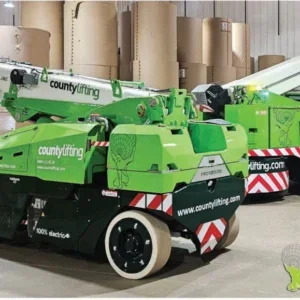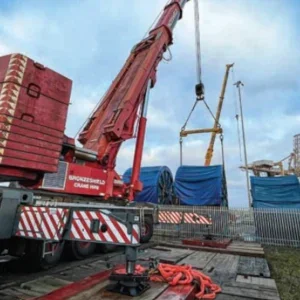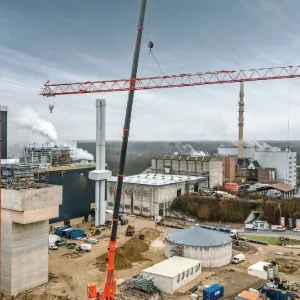LIFTING GENERATOR AND TURBINE TAKES TEAM WORK The classic application for hydraulic jacking gantries is indoor industrial installations were height restrictions make the use of a heavy lifting crane impossible. Such a project was completed in November by Team Heavylift International of the Netherlands. Working for Siemens in Austria, the specialist contractor installed a generator and a gas turbine.
The first stage of the project was to lift a 300t generator off a trailer and place it on a block inside the building. A 4 Point Lift Systems type 48A gantry was used to lift the generator 3.5m from the ground – the height of the block. At this height, with the lifting beams at a height of more than 10m, the lift system travelled 16m into the building and lowered the load onto its foundation. A separate skidding system on top of the beams was used to position the generator and exactly align it over its anchor blocks.
Stage two of the job was the installation of the 300t turbine at the other side of the generator block. The 4 Point lift system was again used to unload the turbine from its trailer and lower it down on conventional skid tracks. After the skidding operation the lift system was repositioned around the turbine, the transport frame removed and the turbine lifted to a height of 4m. At this height the load travelled forwards about 4m and was then lowered exactly onto its foundations. Accuracy was again ensured by the skidding system on top of the beams.
THE DUTCH KEEP THEIR WINDMILL INTACT An electricity-generating windmill in Rotterdam harbour was shifted 400m one Saturday in September to make way for the area to be redeveloped. The decision was taken to shift it completely assembled and in a vertical position rather than taking it apart and rebuilding it.
The Quadro windmill has four separate turbines on its 50m-high mast and their combined 300kW capacity is enough to generate electricity for 250 houses.
Before the windmill was transported the whole structure had to be jacked up. Lifting contractor Van Seumeren used 32 specially designed bolt attachments to secure two steel jacking beams onto the upper face of the octagonal foundation. The beams and windmill were then jacked up using four 600t-capacity climbing jacks until a clearance of 1.5m was attained.
Two sets of 12 lines of Kamag self-propelled modular trailers were then slid underneath and the load lowered onto them for transportation.
Halfway through the journey the load was turned through 180o to bring the trailers’ powerpacks to the front to optimise space for placing the windmill at its destination. On arrival the windmill was inspected by Lagerwey Windturbine and is now expected to continue producing electricity for the energy company Eneco for a further 10 years.
RAISING THE DOUGHNUT When East Midlands Airport in the UK was upgraded, the project included a new control tower. Subcontractor Bierrum & Partners, working to main contractor Christiani & Nielsen, was faced with the challenge of getting the 90t sub-cab up to the top of the 50m-high tower.
The solution was provided by specialist lifting contractor PSC Heavy Lift which assembled a lifting pack at the top of the tower and connected eight jacking strands, each 18mm diameter, to the doughnut-shaped control room.
LIFT-N-LOCK ASSISTS IN HEAVYWEIGHT DELIVERY Argentinian rigging contractor Javier Cortes unloads a Russian Antonov cargo plane at Buenos Aires airport using a 1200 series Lift-N-Lock hydraulic boom gantry.
The gantry, built by J&R Engineering Company of the USA, is seen supporting a 90t rotor which was being delivered for a power generator last April. This particular gantry is designated as a 1200-4-35 model, signifying that it has a 1200 US ton capacity, four legs, and a 35ft (10.7m) maximum lifting height.
LIFT SYSTEMS’ MOBILIFT New from 4 Point Lift Systems is the Mobilift, a 50t capacity telescopic forklift, known more formally as the TF 55 (reflecting its 55 US tons capacity).
The four-wheeled lifter has a maximum lifting height of 5.5m, where its lifting capacity is 22.7t, and an outreach from the front bumper of 3.7m. The maximum load of 50t can be lifted to a height of 2.7m.
It has 90o steering in the rear wheels with a 4.9m minimum outside truning radius to allow 360o rotation. Power comes from a Cummins four cylinder, turbo-charged, 116bhp diesel engine.
A pin-on extension to the two-section boom is available as an option, instead of lifting forks. A 3m-long jib has a 9.1t lifting capacity, which is reduced to 4.5t when a 1.5m stinger, or fly jib, is also added.






